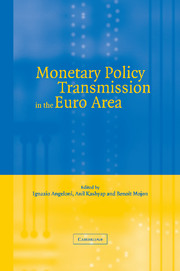 Monetary Policy Transmission in the Euro Area
Monetary Policy Transmission in the Euro Area Published online by Cambridge University Press: 22 September 2009
Introduction
This chapter tests cross-sectional differences in the effectiveness of the bank-lending channel of monetary policy transmission in Italy from 1986 to 1998. Several studies (including Angeloni et al., 1995; Bagliano and Favero, 1995; Buttiglione and Ferri, 1994; Chiades and Gambacorta, 2003; Fanelli and Paruolo, 1999) have shown that the bank-lending channel was at work in Italy. However, the cross-sectional predictions of the lending channel have not been systematically explored.
Panel data are used to study the response of bank deposits and loans to monetary shocks, and tests are proposed to see if these responses depend on the size, the liquidity position, or the capitalisation of banks. Such tests have not previously been conducted using comprehensive data on Italian banks. The main difference with respect to Ehrmann et al. (chapter 14 in this volume) lies in the additional tests that are conducted regarding deposits and liquidity: according to the bank-lending channel hypothesis, deposits and liquid assets, together with bank loans, should also fall after a monetary restriction. These tests therefore allow us to identify a loan-supply shock correctly.
The remainder of the chapter is organised as follows. Section 2 analyses the institutional characteristics of the Italian economy in the 1980s and 1990s. After a brief description of the data in section 3, section 4 presents evidence on the response of lending to a monetary shock, while section 5 analyses the effects on deposits and liquidity. Section 6 summarises the main conclusions.
To save this book to your Kindle, first ensure [email protected] is added to your Approved Personal Document E-mail List under your Personal Document Settings on the Manage Your Content and Devices page of your Amazon account. Then enter the ‘name’ part of your Kindle email address below. Find out more about saving to your Kindle.
Note you can select to save to either the @free.kindle.com or @kindle.com variations. ‘@free.kindle.com’ emails are free but can only be saved to your device when it is connected to wi-fi. ‘@kindle.com’ emails can be delivered even when you are not connected to wi-fi, but note that service fees apply.
Find out more about the Kindle Personal Document Service.
To save content items to your account, please confirm that you agree to abide by our usage policies. If this is the first time you use this feature, you will be asked to authorise Cambridge Core to connect with your account. Find out more about saving content to Dropbox.
To save content items to your account, please confirm that you agree to abide by our usage policies. If this is the first time you use this feature, you will be asked to authorise Cambridge Core to connect with your account. Find out more about saving content to Google Drive.